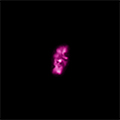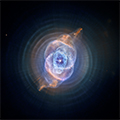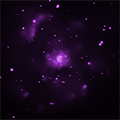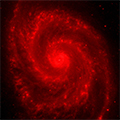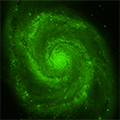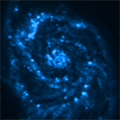CXC Home | Search | Help | Image Use Policy | Latest Images | Privacy | Accessibility | Glossary | Q&A
Download this video (MP4)
Chandra Deep Field South
Credit: NASA/CXC/SAO/K.Arcand, SYSTEM Sounds (M. Russo, A. Santaguida)
[Runtime: 00:48]
 Audio Only Versions
Audio Only Versions
This is the deepest image ever taken in X-rays, representing over seven million seconds of Chandra observing time. For that reason, and because the observed field is in the southern hemisphere, astronomers call this region the "Chandra Deep Field South". At first glance, this image may appear to be a view of stars. Rather, almost all these different colored dots are black holes or galaxies. Most of the former are supermassive black holes that reside at the centers of galaxies. In this data sonification, the colors dictate the tones as the bar moves from the bottom of the image to the top. More specifically, colors toward the red end of the rainbow are heard as low tones while colors towards purple are assigned to higher ones. Light that appears bright white in the image is heard as white noise. The wide range of musical frequencies represents the full range of X-ray frequencies collected by Chandra of this region. In the visual color image, this large frequency range in X-rays had to be compressed to be shown as red, green, and blue for low, medium, and high-energy X-rays. Played as sound, however, the full range of data can be experienced. As the piece scans upward, the stereo position of the sounds can help distinguish the position of the sources from left to right.
Credit: NASA/CXC/SAO/K.Arcand, SYSTEM Sounds (M. Russo, A. Santaguida)
[Runtime: 00:48]
 Audio Only Versions
Audio Only Versions
This is the deepest image ever taken in X-rays, representing over seven million seconds of Chandra observing time. For that reason, and because the observed field is in the southern hemisphere, astronomers call this region the "Chandra Deep Field South". At first glance, this image may appear to be a view of stars. Rather, almost all these different colored dots are black holes or galaxies. Most of the former are supermassive black holes that reside at the centers of galaxies. In this data sonification, the colors dictate the tones as the bar moves from the bottom of the image to the top. More specifically, colors toward the red end of the rainbow are heard as low tones while colors towards purple are assigned to higher ones. Light that appears bright white in the image is heard as white noise. The wide range of musical frequencies represents the full range of X-ray frequencies collected by Chandra of this region. In the visual color image, this large frequency range in X-rays had to be compressed to be shown as red, green, and blue for low, medium, and high-energy X-rays. Played as sound, however, the full range of data can be experienced. As the piece scans upward, the stereo position of the sounds can help distinguish the position of the sources from left to right.
Download this video (MP4)
Cat's Eye Nebula (NGC 6543) Sonification
Credit: NASA/CXC/SAO/K.Arcand, SYSTEM Sounds (M. Russo, A. Santaguida)
[Runtime: 00:34]
 Audio Only Versions
Audio Only Versions
When a star like the Sun begins to run out of helium to burn, it will blow off huge clouds of gas and dust. These outbursts can form spectacular structures such as the one seen in the Cat's Eye nebula. This image of the Cat's Eye contains both X-rays from Chandra around the center and visible light data from the Hubble Space Telescope, which show the series of bubbles expelled by the star over time. To listen to these data, there is a radar-like scan that moves clockwise emanating from the center point to produce pitch. Light that is further from the center is heard as higher pitches while brighter light is louder. The X-rays are represented by a harsher sound, while the visible light data sound smoother. The circular rings create a constant hum, interrupted by a few sounds from spokes in the data. The rising and falling pitches that can be heard are due to the radar scan passing across the shells and jets in the nebula.
Credit: NASA/CXC/SAO/K.Arcand, SYSTEM Sounds (M. Russo, A. Santaguida)
[Runtime: 00:34]
 Audio Only Versions
Audio Only Versions
When a star like the Sun begins to run out of helium to burn, it will blow off huge clouds of gas and dust. These outbursts can form spectacular structures such as the one seen in the Cat's Eye nebula. This image of the Cat's Eye contains both X-rays from Chandra around the center and visible light data from the Hubble Space Telescope, which show the series of bubbles expelled by the star over time. To listen to these data, there is a radar-like scan that moves clockwise emanating from the center point to produce pitch. Light that is further from the center is heard as higher pitches while brighter light is louder. The X-rays are represented by a harsher sound, while the visible light data sound smoother. The circular rings create a constant hum, interrupted by a few sounds from spokes in the data. The rising and falling pitches that can be heard are due to the radar scan passing across the shells and jets in the nebula.
Download this video (MP4)
M51 (Whirlpool Galaxy) Sonification
Credit: NASA/CXC/SAO/K.Arcand, SYSTEM Sounds (M. Russo, A. Santaguida)
[Runtime: 00:32]
 Audio Only Versions
Audio Only Versions
Messier 51 (M51) is perhaps better known by its nickname of the Whirlpool Galaxy because its face-on orientation to Earth reveals its wound-up spiral arms. This gives telescopes here a view of another spiral galaxy similar to our Milky Way, whose structure we cannot observe directly from our position within it. As with the Cat's Eye, the sonification begins at the top and moves radially around the image in a clockwise direction. The radius is mapped to notes of a melodic minor scale. Each wavelength of light in the image obtained from NASA telescopes in space (infrared, optical, ultraviolet, and X-ray) is assigned to a different frequency range. The sequence begins with sounds from all four types of light, but then separately moves through the data from Spitzer, Hubble, GALEX, and Chandra. At wavelengths in which the spiral arms are prominent, the pitches creep upwards as the spiral reaches farther from the core. A constant low hum associated with the bright core can be heard, punctuated by short sounds from compact sources of light within the galaxy.
Credit: NASA/CXC/SAO/K.Arcand, SYSTEM Sounds (M. Russo, A. Santaguida)
[Runtime: 00:32]
 Audio Only Versions
Audio Only Versions
Messier 51 (M51) is perhaps better known by its nickname of the Whirlpool Galaxy because its face-on orientation to Earth reveals its wound-up spiral arms. This gives telescopes here a view of another spiral galaxy similar to our Milky Way, whose structure we cannot observe directly from our position within it. As with the Cat's Eye, the sonification begins at the top and moves radially around the image in a clockwise direction. The radius is mapped to notes of a melodic minor scale. Each wavelength of light in the image obtained from NASA telescopes in space (infrared, optical, ultraviolet, and X-ray) is assigned to a different frequency range. The sequence begins with sounds from all four types of light, but then separately moves through the data from Spitzer, Hubble, GALEX, and Chandra. At wavelengths in which the spiral arms are prominent, the pitches creep upwards as the spiral reaches farther from the core. A constant low hum associated with the bright core can be heard, punctuated by short sounds from compact sources of light within the galaxy.
Download this video (MP4)
A Tour of Data Sonification: Stellar, Galactic, and Black Hole
(Credit: NASA/CXC/A. Hobart)
[Runtime: 04:08]
With closed-captions (at YouTube)
As part of our ongoing data sonification series, three new images have now been released. In this project, astronomical data collected by NASA's Chandra X-ray Observatory and other telescopes are translated into sounds. Data sonification converts the data from these space-based telescopes into a form that users can hear instead of only see, embodying the data in a new form without changing the original content.
These three images include some of the most famous objects associated with Chandra. The first is the Chandra Deep Field, which contains some 7 million seconds worth of the telescope's observing time. At first glance, this image may appear to be a view of stars. Rather, almost all these different colored dots are black holes or galaxies. Most of the former are supermassive black holes that reside at the centers of galaxies. In this data sonification, the colors dictate the tones as the bar moves from the bottom of the image to the top. More specifically, colors toward the red end of the rainbow are heard as low tones while colors towards purple are assigned to higher ones. Light that appears bright white in the image is heard as white noise.
The second new image is the planetary nebula known as the Cat's Eye. When a star like the Sun begins to run out of helium to burn, it will blow off huge clouds of gas and dust. These outbursts can form spectacular structures such as the one seen in the Cat's Eye nebula. This image of the Cat's Eye contains both X-rays from Chandra around the center and visible light data from the Hubble Space Telescope, which show the series of bubbles expelled by the star over time. To listen to these data, there is a radar-like scan that moves clockwise emanating from the center point to produce pitch. Light that is further from the center is heard as higher pitches while brighter light is louder.
The final member of this trio of newly sonified images is the Whirlpool Galaxy, which also goes by its formal name of Messier 51. The Whirlpool is oriented face-on to Earth, giving telescopes here a view of another spiral galaxy similar to our Milky Way. As with the Cat's Eye, the sonification begins at the top and moves radially around the image in a clockwise direction. The radius is mapped to notes of a melodic minor scale. Each wavelength of light in the image obtained from NASA telescopes in space (infrared, optical, ultraviolet, and X-ray) is assigned to a different frequency range. The sequence begins with sounds from all four types of light, but then separately moves through the data from Spitzer, Hubble, GALEX, and Chandra.
(Credit: NASA/CXC/A. Hobart)
[Runtime: 04:08]
With closed-captions (at YouTube)
As part of our ongoing data sonification series, three new images have now been released. In this project, astronomical data collected by NASA's Chandra X-ray Observatory and other telescopes are translated into sounds. Data sonification converts the data from these space-based telescopes into a form that users can hear instead of only see, embodying the data in a new form without changing the original content.
These three images include some of the most famous objects associated with Chandra. The first is the Chandra Deep Field, which contains some 7 million seconds worth of the telescope's observing time. At first glance, this image may appear to be a view of stars. Rather, almost all these different colored dots are black holes or galaxies. Most of the former are supermassive black holes that reside at the centers of galaxies. In this data sonification, the colors dictate the tones as the bar moves from the bottom of the image to the top. More specifically, colors toward the red end of the rainbow are heard as low tones while colors towards purple are assigned to higher ones. Light that appears bright white in the image is heard as white noise.
The second new image is the planetary nebula known as the Cat's Eye. When a star like the Sun begins to run out of helium to burn, it will blow off huge clouds of gas and dust. These outbursts can form spectacular structures such as the one seen in the Cat's Eye nebula. This image of the Cat's Eye contains both X-rays from Chandra around the center and visible light data from the Hubble Space Telescope, which show the series of bubbles expelled by the star over time. To listen to these data, there is a radar-like scan that moves clockwise emanating from the center point to produce pitch. Light that is further from the center is heard as higher pitches while brighter light is louder.
The final member of this trio of newly sonified images is the Whirlpool Galaxy, which also goes by its formal name of Messier 51. The Whirlpool is oriented face-on to Earth, giving telescopes here a view of another spiral galaxy similar to our Milky Way. As with the Cat's Eye, the sonification begins at the top and moves radially around the image in a clockwise direction. The radius is mapped to notes of a melodic minor scale. Each wavelength of light in the image obtained from NASA telescopes in space (infrared, optical, ultraviolet, and X-ray) is assigned to a different frequency range. The sequence begins with sounds from all four types of light, but then separately moves through the data from Spitzer, Hubble, GALEX, and Chandra.
Download this video (MP4)
A Quick Look at Data Sonification: Stellar, Galactic, and Black Hole
(Credit: NASA/CXC/A. Hobart)
[Runtime: 00:45]
Three images from space can now not only be seen, but also heard.
They are part of a project that converts data from telescopes into sounds.
The project uses data from NASA's Chandra X-ray Observatory and other telescopes
Data sonification creates new ways to enjoy the exciting discoveries of the Universe.
(Credit: NASA/CXC/A. Hobart)
[Runtime: 00:45]
Three images from space can now not only be seen, but also heard.
They are part of a project that converts data from telescopes into sounds.
The project uses data from NASA's Chandra X-ray Observatory and other telescopes
Data sonification creates new ways to enjoy the exciting discoveries of the Universe.
Audio Only Versions (Downloads)
| MP3 | OGG | M4R | |
|---|---|---|---|
| X-ray | .mp3 | .ogg | .m4r |
| MP3 | OGG | M4R | |
|---|---|---|---|
| All Wavelengths | .mp3 | .ogg | .m4r |
| X-ray | .mp3 | .ogg | .m4r |
| Optical | .mp3 | .ogg | .m4r |
| MP3 | OGG | M4R | |
|---|---|---|---|
| All Wavelengths | .mp3 | .ogg | .m4r |
| X-ray Only | .mp3 | .ogg | .m4r |
| Infrared Only | .mp3 | .ogg | .m4r |
| Optical Only | .mp3 | .ogg | .m4r |
| Ultraviolet Only | .mp3 | .ogg | .m4r |
Return to Data Sonification: Stellar, Galactic, and Black Hole (March 24, 2021)


